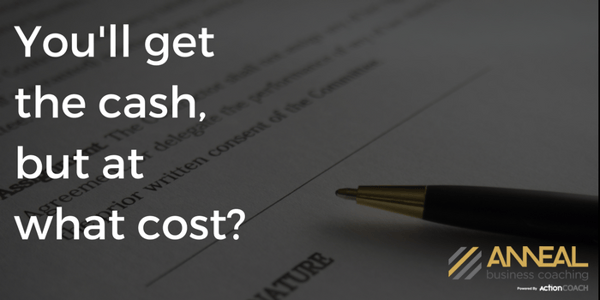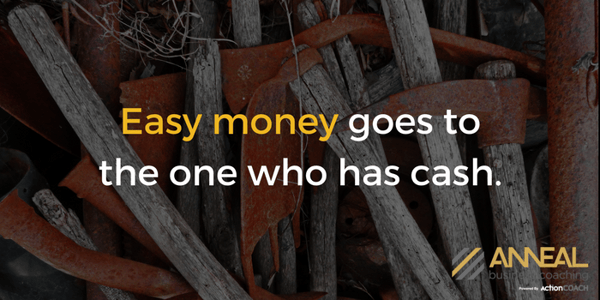5 MIN READ
I suspect that most of us could use an extra $100,000 in cash.
It would sure be nice to have cash to pay down the line of credit, get current with suppliers, or catch up on payroll taxes. Access to easy cash makes so-named merchant loans pretty attractive.
You know the loans, they’re the ones where they make a few cursory checks of your credit score and bank statements then wire money directly into your account. Presto, cash problems resolved (for the time being anyway).
Sounds too good to be true doesn’t it? It is.

Oh, you’ll get the cash all right, but at what cost? Would you take the loan if you had to pay a 36%, 50% or higher annual interest rate? That’s the kind of equivalent rate these loans command and that’s not the only catch.
"The loan solves our cash flow problem for a day. The very next day, it becomes our cash flow problem."
The lenders start taking their money back out of the account the day after the deposit. The daily draws vary. Some are based on a percentage of sales, and some are based on other formulas, but the lenders generally get their money back in 6-9 months, sometimes sooner.
The loan solves our cash flow problem for a day. The very next day, it becomes our cash flow problem.
After his experience with a couple of these loans, a former client of mine began calling them the “gangster loans.” That’s because he was enticed by easy money to sign up for a more than 50% equivalent interest rate and stifling repayment terms.
Don’t get me wrong. Nobody made him do it, and he was entirely responsible for his actions. However, he did not understand the high cost of the loan because the equivalent interest rates were not obvious. They were hidden in the terms of the agreements that require some deciphering to unravel.
"The equivalent interest rates were not obvious. They were hidden in the terms of the agreements that require some deciphering to unravel."
See if you can spot the interest rate in another deal I recently came across.
A lender advanced the business $100,000, and the owners agreed to repay $109,000. The extra $9,000 was the lender’s “fee” for making the loan. That $9,000 sure looks a lot like a 9% annual interest rate. It’s not.
It would be if the business had the entire $100,000 for an entire year, but that’s not what happened. The lender began taking their money back the day after the deposit and they had it all back in six months. That means the company had an average of half the money for half a year or an average of a fourth of the money for a full year.
I’ll ask you to take my word for it here, but that raises the equivalent annual interest rate by 4 times, from 9% to 36%. (Double because they only averaged half the money, double again because they only had it for half a year)! Yikes, and the more quickly the lender recovers the money, the higher the effective interest rate.
You may be offended by this sleight of hand, but you also may be thinking you’d like to get in on the action. You wouldn’t object to earning that kind of interest, and you can. The opportunity is likely to be sitting in your inbox right now in the form of invoices from your suppliers.
Many suppliers offer “2/10 net 30” terms which means they will accept 2% less, or $98,000, to settle a $100,000 invoice if we pay within ten days. Otherwise we owe the full $100,000 within 30 days.
In effect they’re paying us $2,000 to give them a $98,000 loan for 20 days. You’ll have to trust me again, but It turns out that 2% for twenty days is also equivalent to a 36% annual interest rate! (365 days in a year/ 20 days = 18 * 2% = 36%). I’ve even seen 5/10 net 30 payment terms which is equivalent to approximately a 90% annual interest rate!
Although the rates in the two examples happen to be the same, there is a big difference. We are paying 36% in one, and we are earning 36% in the other. The spread between the two represents a huge difference that can work for us or against us.
Who pays and who earns is entirely a matter of who has cash and who doesn’t.
In the first example the merchant lender had the money, and we needed it. In the second example the supplier needed the money and we had it. The high return, easy money goes to the one who has cash.

The willingness of businesses to pay the high cost of merchant loans and of our suppliers to grant 2/10 credit terms again demonstrates the critical importance of cash.
They are two more powerful reasons to understand and manage our cash and build a cash reserve. They are also incentives to curate our finances and financial statements so we can use conventional bank lending, which costs only a small fraction of the cost of gangster loans.
(Hmmmm…. Maybe we could borrow from the bank at 6% and earn 36% from our suppliers on our 2/10 terms!)
Have you used a merchant or credit card cash loan? Did you earn more than the loan cost you? Do you know if you did or not? Do you know what the loan cost you? Do you take advantage of supplier discount terms? Can you use conventional bank financing?